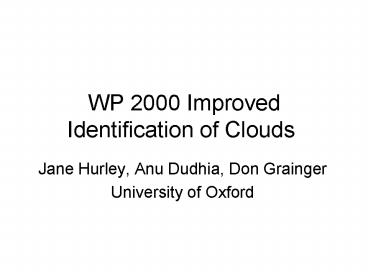WP 2000 Improved Identification of Clouds - PowerPoint PPT Presentation
1 / 19
Title:
WP 2000 Improved Identification of Clouds
Description:
Use SVclear to do a Least Squares Fit (LSF) on Original-Mean signal; ... Radiance of cloud LSVcloud = mean(Si (fit coeff)i SVcloud i), where i ranges ... – PowerPoint PPT presentation
Number of Views:30
Avg rating:3.0/5.0
Title: WP 2000 Improved Identification of Clouds
1
WP 2000 Improved Identification of Clouds
- Jane Hurley, Anu Dudhia, Don Grainger
- University of Oxford
2
Current Cloud Detection
- Colour Index (CI) Method is now used to detect
cloud - A couple of caveats however
- microwindows have not been optimized would be
useful if CI EF - fails to detect cloud with cloud fraction lt 30
3
(No Transcript)
4
- Objective
- To create and analyze RFM-simulated cloudy
spectrum of varying cloud effective fraction EF
to formulate a new cloud detection method using
Singular Vector Decomposition SVD. - Singular Vector Decomposition SVD
- is statistical technique used for finding
patterns in high dimensional data - transforms a number of potentially correlated
variables into a smaller number of uncorrelated
variables (SINGULAR VECTORS) - first SV captures the most variance and each
successive SV captures increasingly less variance - Idea is to find singular vectors that describe
clear and cloudy atmospheres and use them in
cloud detection
5
Clear Singular Vectors
RFM-simulated spectrum with EF 0 and 9.0km
tangent height and the corresponding first 8
Clear Singular Vectors SVclear
- Use 2nd half of A band because more sensitive to
cloud presence
6
Need only first few SVs to well represent signal
First 3 SVs capture 90 of total variance
7
Cloudy Singular Vectors
- Subtract off mean spectral radiance from Original
signal - Use SVclear to do a Least Squares Fit (LSF) on
Original-Mean signal - Subtract LSF from Original signal to get
Cloud-Only signal.
8
- Compare with Aerosol signature with same EF in
the FOV - SVD-calculated Cloud-only signal
- Aerosol signal
Do SVD on Cloud-only signal to get Cloudy
Singular Vectors SVcloud
9
Application to MIPAS data
Use SVclear and SVcloud for given tangent height
to do a LSF to mean-subtracted Original signal
6 km
EF ? 0 ? Non-zero fit coefficient to SVcloud!
10
Cloud Detection
Method 1 ?2 Ratio Use SVclear and SVcloud to do
LSF of arbitrary spectrum. Use ?2 error to
measure goodness of fit.
11
Method 2 Ratio of Integrated Reconstructed
Radiances Use SVclear and SVcloud to do LSF of
arbitrary spectrum. Reconstruct cloudy and total
radiance using LSF.
12
Comparison of Methods
- 4 Methods of Cloud Detection
- Radiance Thresholding
- Colour Index
- SVD ?2 Ratio
- SVD Ratio of Integrated Reconstructed Radiances
Methods applied to RFM Data Percent that
method gets prognosis right
Methods applied to MIPAS 2003 data Percent
agreement between methods
13
Future Work
Finish selecting optimal microwindows for use
with Colour Index Method those that best
correlate with EF. Finalize choice of thresholds
for SVD Methods. Compare methods of cloud
detection on large MIPAS dataset against known
databases (ISCCP) etc to see what difference this
makes. Do SVD analysis of ice clouds and
implement this into an identification scheme.
Hopefully will then have a cloud type
identification scheme.
14
(No Transcript)
15
For RFM-simulated spectra
16
- For MIPAS data, not so sharp a distribution,
obviously but clearly a bimodal distribution - Can fit a Gaussian to clear peak and set a
threshold - thr peak 3st.dev.
- Should pick up 99.5 of cloud, if truly Gaussian
17
Cloud Detection
- Method 1 ?2 Ratio
- Use SVclear and SVcloud to do LSF of arbitrary
spectrum. - Use ?2 error to measure goodness of fit.
- Fit given spectrum with SVclear ? ?2clear
- Fit given spectrum with SVclear and SVcloud ?
?2clearcloud - Consider ratio of ?2clear / ?2clearcloud
- ?2clear / ?2clearcloud gt 1 for cloudy spectra
- ?2clear / ?2clearcloud 1 for clear spectra
18
Application to RFM-simulated spectra
19
- Method 2 Ratio of Integrated Reconstructed
Radiances - Use SVclear and SVcloud to do LSF of arbitrary
spectrum. - Radiance of cloud LSVcloud mean(Si (fit coeff)i
SVcloud i), where i ranges over the cloudy SVs
only and average over spectral points. - LSVcloud 0 for clear spectra
- LSVcloud gt 0 for cloudy spectra
- Total radiance LSVall mean(Si (fit coeff)i
SVi), where i ranges over all SVs and average
over spectral points. - Consider ratio LSVcloud / LSVall
- LSVcloud / LSVall 0 for clear spectra
- LSVcloud / LSVall gt 0 for cloudy spectra






























